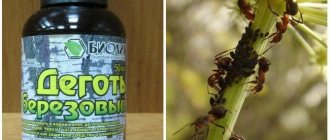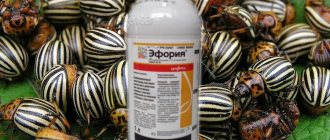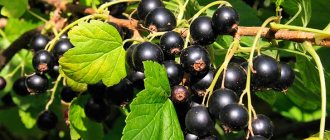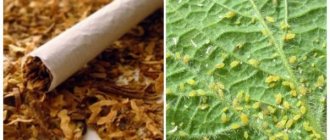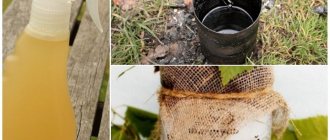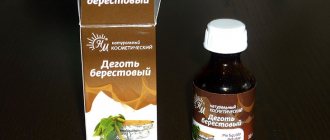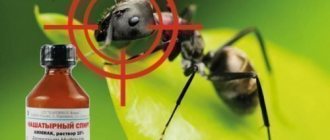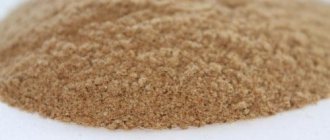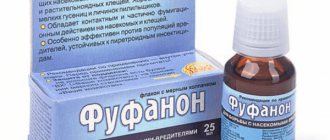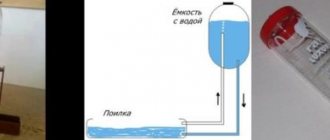Hello dear gardeners.
Birch tar is another powerful pest repellent.
It can be used to spray vegetables and kill rodents, mole crickets and aphids. I’ll tell you how to make it yourself and how to use it effectively in your dacha in this article.
Birch tar is the resin of the tree of the same name. This substance is used in folk medicine, veterinary medicine and gardening, and in the old days they used a universal remedy to repair wheels and actively used it in everyday life.
Thanks to its special smell, tar is an excellent product that repels harmful insects; it also drives away other uninvited guests from the garden.
Interestingly, birch resin does not kill pests, but repels them with a pungent odor. It is completely safe for plants and animals living in the garden. This article will tell you what is remarkable about the product.
Birch tar - use in the garden
Birch tar is made from birch bark by heating in special hermetically sealed containers. The output is an oily viscous mass of dark brown, almost black color, with a sharp characteristic odor. This is just what you need to repel pests in your garden and garden. It is used on almost all crops that need protection from insects. These are onions, carrots, all cruciferous and nightshade crops. It can be used to water young seedlings of annual flowers planted in open ground, as well as shrubs and fruit trees.
When using a plant protection solution, it is necessary to take into account some points.
- Tar does not dissolve well in water. Therefore, first add a soap solution, and only then add resin. Only after this they begin to process the plants.
- After using the solution, the remaining product is difficult to wash off from the watering can, so a separate container is used for processing.
- When spraying, it is better not to use expensive sprinklers; small oil drops will fill the nozzle holes, and the device may fail.
- To prevent your hands from smelling unpleasantly after treatment, wear rubber gloves with high cuffs when performing treatment.
- Do not treat plants immediately after rain or watering of plants, or if rain is forecast in the near future. Otherwise, the processing will be useless, and you will waste your time and energy.
- The treatment is carried out in dry and windless weather, preferably in the evening when the sun has set. You cannot carry out the treatment during the day in the brightly scorching sun, and do not exceed the dosage of the drug, otherwise the leaves will turn black after treatment.
Disadvantages of birch tar
- A sharp unpleasant smell will cause discontent among neighbors or passers-by;
- The drug acts on both harmful insects and pollinating insects, including bees, which can affect the yield of bee-pollinated crops;
- The above-ground part of the plants cannot be processed; they cannot then be eaten because of the unpleasant odor;
- Not recommended for indoor plants;
- It stains clothes, which are then very difficult to wash;
- The concentration of the solution must not be exceeded during processing. Concentrated tar is toxic; working solutions with it must be prepared with precautions for substances of the 3rd hazard class.
Tar soap can also be used in pest control, but it is not as fragrant as the resin itself. And if you use it, you need to take much more of it, which is not entirely economical.
Characteristics and release form
A natural remedy is a natural repellent that has long been used in agriculture. A dark, thick mass with a specific heavy odor is obtained by thermal decomposition of wood. Includes:
- resins;
- phenol;
- toluene;
- xylene
Birch tar is made from chips, bark and knots, birch bark preparation is made from the young cork layer of a tree. The first product has a richer odor and a high concentration of substances, the second is more suitable for cosmetic procedures and the production of medicines. The dark liquid is packaged in glass bottles with a capacity of 20 to 100 ml.
Tar soap is produced in the form of a bar, packaged in polyethylene. The option with the addition of surfactants is classified as detergents, not antiseptics. The low content of antibacterial components excludes the benefit when used against pests.
How to dilute birch tar in water for spraying
For watering or spraying plants, the solution is prepared in the same way to protect against all types of pests.
First, dissolve 2 tbsp in 1 liter of warm water. l. liquid soap or planed laundry soap (powder), mix everything thoroughly.
Only then add 1 tbsp. l. birch tar, and mix everything well again.
The result is a mother solution, which is added to 9 liters of water. After this you will get a working solution. The plants are watered or sprayed with the prepared working solution.
Compared to chemicals, birch resin has many advantages.
- Effective against many insects and pests - onion and carrot flies, cabbage butterflies, strawberry weevils, Colorado potato beetles, etc. The drug is also effective against moles, shrews and mole crickets, and perfectly repels rodents.
- The solution is prepared quite simply, it can be sprayed on plants or watered at the root; the drug also does not have a negative effect on the soil;
- The effect of the product after treatment lasts up to 3-4 weeks, and sometimes one treatment is enough for the entire season;
- The drug is safe for humans and plants. After processing, root vegetables do not smell at all like tar, and their taste does not change. However, it should be noted that berries and the above-ground parts of plants (onions, cabbage) can retain the smell for quite a long time, so avoid getting the solution on the above-ground parts of the plants.
Video
The antiseptic, antiparasitic and antimicrobial effects of birch tar have been known to people for a long time. The liquid product of dry distillation of birch can be used in the garden and garden. In many languages, the word originally meant only pine tar for tarring ships. In Rus' it was more often called var or resin. There are currently no clear differences between the terms. Birch tar is not a fertilizer, it is most likely a repellent. Its main task is to repel pests with its smell and mask the smell of plants. This wonderful, 100% natural remedy perfectly protects against a whole galaxy of pests - onion flies, wireworms, Colorado potato beetles, caterpillars on cabbage, etc.
It is very important to know that the resin does not kill pests as it is not a pesticide. From this we can conclude that the solution is used until the plants are attacked by pests.
Birch var is successfully used in folk medicine and cosmetology, for healing wounds and burns. When used externally, skin regeneration occurs faster. When taken orally, the purified drug has a positive effect on the body, normalizing blood pressure, improving metabolism, and strengthening the heart. Tar suppresses the growth of cancer cells, preventing degeneration into malignant tumors, and neutralizes the effects of chemotherapy.
However, not many people use it, since not everyone likes the specific smell. How to properly apply and apply the solution, what pests it helps against, how often to carry out treatments, all this will be discussed further in the article.
Birch tar - how to use it against pests
The smell of tar lingers in the ground for 20-23 days; on the surface, the smell evaporates faster, so the aboveground part of the plants is re-treated.
Onion, carrot, cabbage fly . Treatment is carried out once every 10 days with moderate precipitation. If there has been heavy rainfall, treatment is carried out more often.
Wireworm and mole cricket . The working solution is applied and infused for 1 hour. Then the potato tubers are soaked in the solution before planting. Or the grooves (holes) are sprayed with the solution before planting the tubers.
Colorado beetle. When the tops grow on the potatoes, the treatment is carried out by spraying the solution. Potatoes with moderate rainfall are sprayed 3-4 times per season. If it rains heavily, of course, treatments need to be carried out more often.
Strawberry weevil. Birch tar is an excellent remedy for repelling weevils on strawberries. The first treatment is carried out immediately after the snow melts and the bushes are treated after winter. The second, when the strawberries threw out their flower stalks and they had not yet opened. And the third is carried out when the buds on the peduncles begin to open.
Spider mite . Spider mites, which are especially active in hot, dry weather, cannot resist the strong aroma of birch resin. The pest is tiny in size, but causes enormous damage to garden and vegetable crops.
the sawfly can damage a wide variety of plants: currants, gooseberries, apple trees, plums, pears, etc. But all varieties of this dangerous insect quickly retreat away from plantings that smell of tar.
Aphid . All gardeners know firsthand how quickly insects turn young shoots into ugly squiggles in any weather. However, the malicious insect has a weak point - it cannot stand the smell of birch resin.
Using sawdust
You can place sawdust in the spaces between the rows, which are soaked in a resin solution. To do this, dilute 3 tbsp per 10 liters of water. l. powdered laundry or liquid soap, stir, add 2 tbsp. l. tar, stir the solution well again, and then soak in the sawdust and place them between onions, carrots, and cabbage. True, this method has disadvantages.
After watering and rain, the efficiency will decrease, and also when loosening the soil, sawdust is embedded in the soil, and then it is necessary to add it again.
Using rags soaked in tar solution
Unnecessary old rags (rags) are soaked in a tar solution and wrapped around a peg, which is stuck into the soil between plantings. The smell repels flies and cabbage butterflies; they do not land on the plants, which means they do not lay larvae.
You can also lay out rags soaked in the working solution on the beds. To do this, take an unnecessary rag, soak it in the solution, or simply drip the product into it in several places. Then place this rag between the rows. When watering or loosening the soil, the rag is removed, and after finishing the work it is placed again in the same place. You can add another drop of the product to enhance the smell.
Self-collection of birch tar
Tar helps drive the mole cricket out of the area, scaring off this insect with a delicate sense of smell with its smell.
Tar solutions can be poured into planting holes of tomatoes, peppers, eggplants and cucumbers. You can also get tar yourself, in the old proven way - using a simple tar plant:
- bury a metal can in the ground to collect tar;
- take a metal pan with a diameter larger than the jar and make a hole in its bottom;
- Place rolled fresh birch bark in a saucepan and place it on a buried jar;
- cover the pan and cover the entire structure with sand, earth or cover it with bricks;
- light a fire on the lid of the pan and around it and maintain moderate heat for 2-3 hours.
After the fire burns out, the jar of tar is dug out of the ground, and the product is poured into a dark container with a tight lid. The shelf life of self-extracted tar is unlimited.
Protecting fruit trees from ants and rodents
Ants also cannot stand the smell of tar, and this is widely used in the fight against it. So, on fruit trees, gardeners make bandages (catching belts) from rags soaked in a solution. But judging by the reviews, applying a bandage directly to a tree trunk leads to a burn to the bark. Therefore, before applying such a bandage, first wrap the trunk several times with cling film or polyethylene. Only then apply a cloth soaked in the product. Also, it should be noted that there is no need to tie the bandage tightly on the trunk, so as not to crush the tree trunk.
To repel the codling moth, trees are sprayed with a working solution, or rags moistened with a resin solution are hung on the branches.
To protect against rodents (for example, hares and mice), whitewash is prepared: 1 bucket of mullein + 1 kg of garden whitewash + 50 g of tar, mix thoroughly until creamy. Then the trees are coated to protect them from rodents.
Which method to choose
So which method should you choose? There are different reviews. But most opinions agree on the need for hygiene as a preventive measure. Do not leave dirty dishes or leftover food, wipe the dining table, store food so that insects do not have access to it, place garbage in plastic bags, and do not forget about wet cleaning of the room. Look, the ants won’t come to you at all.
Ants have no place in our home (apartment, cottage, greenhouse, garden, vegetable garden), and their colonies must be decisively disposed of. Choose one of the methods suggested above. And if it doesn’t seem very effective, try something else. Don't forget about prevention. And don’t put off the fight until later: ants, like many other insects, multiply exponentially, and the sooner you start fighting them, the faster you will achieve success. Good luck to you!
Natural remedy against aphids
Tar soap is well used against aphids. It is very popular among gardeners, who have come up with many different recipes. To prepare an effective solution you will need:
- large bucket (10 l);
- standard packaging of tar soap;
- wood ash – 300 g;
- hot water – 10 l;
- large spoon for mixing ingredients;
- kitchen grater.
Tar soap is effectively used for various purposes, including the destruction of harmful insects.
The illustration for the article is used under the standard license ofazende.ru Before preparing the solution, you need to grate the soap. After this, pour 10 liters of hot water into a bucket (it should not be boiling), pour crushed soap into it, stir well and leave to cool for about an hour. After the water has cooled, you need to mix everything again until smooth, and then add well-sifted ash (300 g) to it. The smaller the grains of ash, the better and more effective the solution will be. Next, you need to stir everything well and leave to infuse for 3 hours. After this time, it is necessary to strain the solution through clean gauze. The anti-aphid preparation is ready, and now you can begin treating the leaves against parasites.
Tar soap is well used against aphids. The illustration for the article is used under the standard license ofazende.ru
Useful remedy against ticks
It’s worth noting right away that in order to avoid these pests on your site, you need to take measures long before they appear. To begin with, it is recommended to cut down all the thickets on the site and carefully mow the grass. After completing this stage, you can directly proceed to preventive treatment of the garden or garden.
First you need to prepare a solution of mustard, soda and tar. Take 2 tablespoons of dry mustard and baking soda and 5 spoons of tar, dissolve all components in a 10-liter bucket of water and mix everything thoroughly. Part of this product must be sprayed over the entire area of the site, and the rest should be treated on all shrubs and trees.
Preparation of working solution
Tar does not dissolve well in water. To prepare the working mixture, it must first be combined with alcohol or alkali. The best method is to dilute the substance with a soap suspension.
It makes no sense to make solutions with different concentrations of the working substance for use on strawberries, apple trees or potatoes. You can make a mixture according to one recipe, and treat the entire area from mice, harmful beetles, butterflies, spider mites, slugs, moles, ants, hares.
Classic solution
First, 50 g of soap (laundry or tar) is grated and soaked in warm water. Then pour in 2 tablespoons of tar and stir well. Dilute in a bucket of water.
This solution can be sprayed on plants, soil, and soaked in mulch and rags.
A universal, potent remedy
The following mixture helps against almost all pests:
- water – 10 l;
- concentrated solution of laundry soap – 1 glass;
- tar - 2 tbsp. l.;
- ammonia - 2 tbsp. l.;
- iodine – 1 tsp;
- pine oil (any) – 1 tsp;
- boric acid – 0.5 tsp.
The mixture must be stirred well. Dilute a half-liter jar of the mixture in 10 liters of water and use it on all crops as a universal remedy against pests, late blight, and powdery mildew.
Repelling moles
To expel moles from the garden, rags soaked in a mixture of tar and vegetable oil in a ratio of 3:2 are placed in their holes. They try to stick the rag as deep as possible, and sprinkle it with earth on top and trample it down.
These events are held in early spring. They are also effective for expelling gophers, mice and other rodents.
The most effective ways:
- A mixture of 15 g of tar and 10 liters of water will help protect against moles and mice. Sawdust is soaked in the solution and buried around the trunks.
- A special whitewash, which is applied in the fall, eliminates the attacks of hares. You need to mix 10 liters of manure, 1 kg of whitewash and 50 g of tar, dilute with water until the consistency of kefir.
